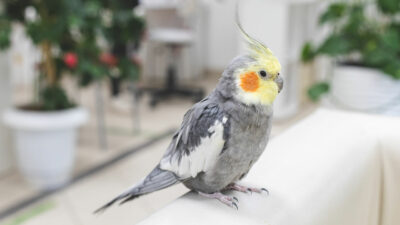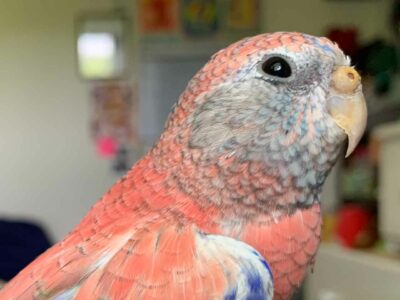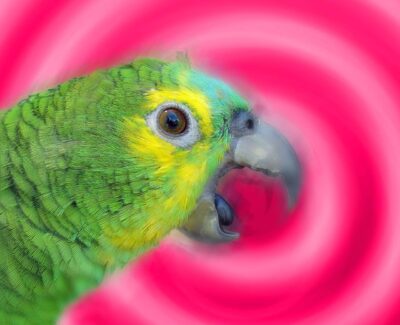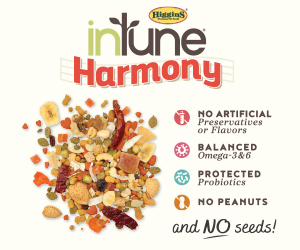
How to Decode Your Bird’s Body Language
Birds, and parrots in particular, are incredibly expressive creatures. Through subtle (and sometimes not-so-subtle) changes in their body language, parrots communicate their feelings, needs, and even their mood swings. Learning to read your parrot’s body language will not only help to deepen your bond, but can also be essential in understanding what they like, what they fear, and how they’re feeling. Read on for a helpful guide to some of the common behaviors you might observe in your feathered friend and what they could mean.
Head Bobbing
Head bobbing can have different meanings depending on the context and the bird’s age. For young birds, especially baby parrots, head bobbing often means that they’re hungry. Adult birds, on the other hand, may bob their heads when they’re feeling excited, seeking attention, or wanting to interact with you. Therefore, this can be a great time to engage with them.
Feather Fluffing
Fluffing up feathers is common and often harmless, but it can have multiple meanings. Birds fluff their feathers to get comfortable, especially when they’re about to sleep or just after waking up. However, if they remain fluffed up for extended periods and seem lethargic, it could indicate that they are not feeling well. If you observe this in your bird—particularly if you also notice signs such as reduced activity or appetite—it may be time to consult your avian veterinarian.
Tail Wagging and Shaking
Just as with dogs, tail wagging is often a sign that your parrot is happy or excited. When they wag their tail, they’re usually in a good mood and may be feeling playful or content. A gentle side-to-side shake of the tail can be a friendly gesture, while fanning out their tail feathers might indicate excitement or, at times, a show of dominance.
Eye Pinning
Eye pinning, which involves the rapid dilation and contraction of a parrot’s pupils, is a unique behavior that often reflects excitement, curiosity, or high alertness. Parrots may pin their eyes when they see something interesting, like a favorite toy or treat, but it can also indicate a defensive mood. When eye pinning is paired with calm behavior, it’s usually a positive sign of interest. However, if paired with other intense behaviors, like ruffled feathers or beak clicking, your bird may feel threatened.
Beak Grinding
Beak grinding is a soft, repetitive sound parrots make by rubbing their upper and lower beaks together. This behavior typically occurs as they’re settling down for a nap or preparing to sleep and is a clear indicator of contentment and relaxation. If you hear your parrot grinding its beak, you can rest assured that they’re feeling comfortable and safe.
Wing Flapping & Stretching
Wing flapping without flying often indicates that your parrot is stretching or releasing excess energy. Birds also flap their wings as part of their exercise routine or to grab your attention. Stretching one wing at a time, especially in the morning, is normal behavior that shows they are preparing for the day. Frequent wing flapping and stretching are generally positive signs that your bird is active and comfortable in their environment.
Tail Bobbing
Tail bobbing, or a rhythmic up-and-down movement of the tail, can be a normal part of a parrot’s breathing pattern after exertion. However, if tail bobbing occurs when they’re at rest, it could potentially indicate respiratory issues. If you observe regular tail bobbing along with labored breathing or lethargy, it’s important to consult an avian vet. Parrots often hide signs of illness, so subtle behaviors like these are important to catch early.
Foot or Toe Tapping
Foot tapping, particularly in smaller species like cockatiels, often indicates excitement or agitation. Sometimes, toe tapping can also result from dietary issues, especially if your bird is sensitive to excessive vitamins or minerals. Occasional foot tapping is generally harmless, but if it becomes chronic, you may want to review your bird’s diet with an avian vet to ensure that they’re receiving balanced nutrition.
Biting and Nipping
Biting in parrots can have various meanings. Birds may bite if they feel threatened, territorial, or overstimulated; however, some parrots also explore their environment by gently nipping, which can be mistaken for aggression. It’s important to differentiate between exploratory nipping and defensive biting. If your parrot is displaying aggressive biting, observe the context—are they protecting their cage or toys, or potentially feeling overstimulated? Understanding the cause can help you handle biting more effectively.
Feather Plucking or Chewing
Feather plucking or excessive preening often signals boredom, stress, or an underlying health issue. Birds may chew or pluck their feathers in response to anxiety, lack of stimulation, or environmental changes. If you notice your bird over-preening or plucking its feathers, consult a vet to rule out any medical causes. Providing more enrichment activities can also be a good way to keep them engaged and reduce stress.
Additionally, female birds may pluck at their inner thighs when they are ovulating—whether or not an egg is actually present. If the bird is overweight, the pressure of the egg development is uncomfortable and pulling feathers in the area offers some relief. Therefore, if you have a female bird, it’s crucial to watch her weight, keep track of ovulation, and discuss any concerns with your vet.
Understanding your bird’s body language is essential for building a trusting relationship. By observing and responding to their unique way of communicating, you can create a bond that helps them feel safe, understood, and loved. Remember that every bird has its own personality, so behaviors can vary. If you’re in need of a qualified avian vet to help you interpret your pet’s signals, be sure to check out our locator tool!





